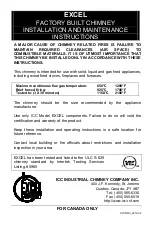
• the temperature to which the body of the product is subject is not homogeneous: from area to area, variable temperatures within
the range of 300°C - 500°C are detected;
• during its life, the product is subject to alternated lighting and extinguishing cycles in the same day, as well as to cycles of intense
use or of absolute standstill when season changes;
• the new appliance, before being considered seasoned has to be subject to many start cycles to allow all materials and paints to
complete the various elastic stresses;
• in detail, initially it is possible to remark the emission of smells typical of metals subject to great thermal stress, as well as of wet
paint. This paint, although during the manufacture it is backed at 250 °C for some hours, must exceed many times and for a given
period of time the temperature of 350 °C before becoming completely embedded in the metallic surfaces.
Therefore, it is extremely relevant to take these easy steps during the lighting:
1. Make sure that a strong air change is assured in the room where the appliance is installed.
2. During the first starts, do not load excessively the combustion chamber (about half the quantity indicated in the instructions manual)
and keep the product continuously ON for at least 6-10 hours with the registers less open than the value indicated in the instructions
manual.
3. Repeat this operation for at least 4-5 or more times, according to your possibilities.
4. Then load more and more fuel (following in any case the provisions contained in the installation booklet concerning maximum load)
and, if possible, keep the lighting periods long avoiding, at least in this initial phase, short ON/OFF cycles.
5. During the first starts, no object should be leaned on the appliance and in detail on enamelled surfaces. Enamelled surfaces must
not be touched during heating.
6. Once the «break-in» has been completed, it is possible to use the product as the motor of a car, avoiding abrupt heating with
excessive loads.
After testing the proper working of the appliance, some days from the installation, it is possible to proceed with the construction
of its aesthetic covering
.
WARNING
: During the surround building operations it must kept in mind possible and subsequent electrical installed parts maintenance
(Fans, temperature probe, etc) and with hydraulic systems all parts connected to the thermo-fireplace.
10.1. LOW EMISSION fire lighting
Smokeless combustion is a way of lighting a fire able to significantly reduce the emission of harmful substances. The wood burns gradually
from the top downwards, so combustion is slower and more controlled. Burnt gases pass through the high temperatures of the flame and
therefore burn almost completely. A load will last from 6 to 8 hours.
Place the logs in the hearth a certain distance apart as shown in the
. Arrange the largest at the bottom and the
smallest at the top, or vertically in the case of tall narrow combustion chambers. Place the fire starter module on top of the pile, arranging
the first logs in the module at right angles to the pile of wood.
Fire STARTER MODULE
This fire starter module replaces a paper or cardboard starter.
Prepare four logs, 20 cm long with a cross section of 3 cm by 3 cm
. Cross the four logs and place them on top of the
pile of wood at right angles, with the fire lighter (wax impregnated wood fibre for example) in the middle. The fire can be lit with a match.
If you want, you can use thinner pieces of wood. In this case, you will need a larger quantity.
Keep the flue gas exhaust valve and combustion air regulator open (
1A
-
2A
). After lighting the fire, leave the combustion air regulator
open in the position shown in the
.
IMPORTANT:
•
do not add further wood between one complete load and the next;
•
do not suffocate the fire by closing the air intakes;
•
regular cleaning by a chimney sweep reduces fine particle emissions.
These instructions are backed by ENERGIA Legno SVIZZERA
11. NORMAL OPERATION
After having positioned the registers correctly, insert the indicated hourly wood load avoiding overloads that cause anomalous stresses
and deformations.
You should always use the product with the door closed in order to avoid damages due to overheating (forge
effect)
.
The inobservance of this rule makes the warranty expire
.
With the registers located on the front of the device, it is possible to adjust the heat emission of the same. They have to be opened
according to the calorific need. The best combustion (with minimum emissions) is reached when, by loading the wood, most part of the air
for combustion flows through the secondary air register.
Never overload the appliance. Too much fuel and too much air for the combustion may cause overheating and then damage the
product.
You should always use the appliance with the door closed in order to avoid damages due to overheating (forge effect).
The adjustment of the registers necessary to reach the rated calorific yield with a depression at the stack of 14 Pa (1,4 mm of column of
water) is the following one: see chap. TECHNICAL DESCRIPTION.
Besides the adjustment of the air for the combustion, the intensity of the combustion and consequently the thermal performance of the
device is influenced by the stack. A good draught of the stack requires a stricter adjustment of air for combustion, while a poor draught
MONOBLOCCHI 1000 - 1300 - 1300H800
22
Содержание Monoblocchi 1000
Страница 2: ......
Страница 6: ...MONOBLOCCHI 1000 1300 1300H800 6 6198101 IT EN DE FR 3 4 ...
Страница 43: ...MONOBLOCCHI 1000 1300 1300H800 6198101 IT EN DE FR 43 1300 H800 MONOBLOCCO PIANO 1300 MONOBLOCCO PIANO ...
Страница 53: ......
Страница 56: ......
Страница 59: ......
















































